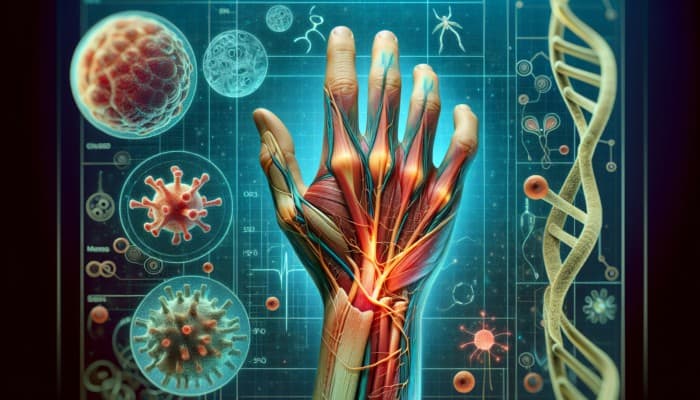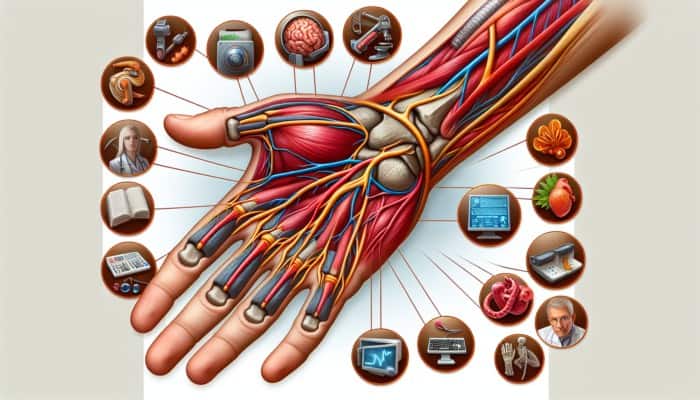Unlocking the Potential of Acupuncture for Carpal Tunnel Syndrome Relief
Acupuncture has emerged as a beacon of hope for individuals suffering from the debilitating effects of carpal tunnel syndrome. This ancient practice not only relieves pain but also addresses the root causes of the discomfort experienced by many. If you're dealing with symptoms such as numbness, tingling, and weakness in your hands and wrists, understanding how acupuncture for carpal tunnel relief works can be truly transformative. In this article, we explore the complexities of carpal tunnel syndrome, the role of acupuncture in alleviating symptoms, and its numerous benefits to those affected.
Delving into the Nature of Carpal Tunnel Syndrome

Defining Carpal Tunnel Syndrome: What You Need to Know
Carpal tunnel syndrome (CTS) is a widespread condition characterised by various uncomfortable sensations experienced in the hand and arm. It arises when the median nerve traverses the carpal tunnel in the wrist and becomes compressed. This compression can lead to symptoms that significantly impede daily tasks and diminish quality of life. Understanding the intricacies of this condition is crucial for those seeking effective treatment options, including acupuncture for carpal tunnel relief.
Identifying Common Symptoms of Carpal Tunnel Syndrome
Individuals living with carpal tunnel syndrome frequently report a distressing array of symptoms, which may include:
– Ongoing pain radiating through the wrist and hand.
– Numbness or tingling sensations that extend into the fingers.
– A noticeable weakness in hand grip, complicating simple tasks such as holding objects.
These symptoms can severely disrupt sleep patterns and daily activities, leading many individuals to seek effective solutions, such as acupuncture for carpal tunnel relief, to regain control over their lives.
Exploring Causes and Risk Factors of Carpal Tunnel Syndrome

Understanding the underlying causes of carpal tunnel syndrome is essential for effective treatment and prevention. Common risk factors for developing this condition include:
– Repetitive hand use: Engaging in activities that require prolonged wrist flexion, such as typing or assembly line work, can significantly contribute to the onset of CTS.
– Wrist injuries: Previous trauma to the wrist can heighten susceptibility to nerve compression.
– Health conditions: Certain medical issues, including diabetes, rheumatoid arthritis, and thyroid disorders, can increase the likelihood of developing CTS.
Recognising these risk factors can empower individuals to take proactive steps to prevent the onset of symptoms and seek timely intervention when necessary.
Understanding How Acupuncture Provides Relief for Carpal Tunnel Syndrome
The Fundamental Principles Behind Acupuncture
Acupuncture is grounded in Traditional Chinese Medicine (TCM) principles, which asserts that vital energy, known as ‘qi', flows through designated pathways within the body. By stimulating specific acupuncture points, practitioners aim to restore balance and alleviate pain. This ancient technique encompasses more than merely inserting needles; it represents a holistic approach to health, addressing symptoms and underlying imbalances contributing to the condition.
Identifying Key Acupuncture Points for Carpal Tunnel Relief

Several specific acupuncture points have proven particularly effective for acupuncture for carpal tunnel relief. Notable points include:
– PC6 (Neiguan): Situated on the inner forearm, this point alleviates wrist pain.
– LI4 (Hegu): Located on the hand, this point is renowned for its pain-relieving properties.
– TH5 (Waiguan): Found on the outer forearm, this point aids in reducing inflammation.
Targeting these critical points can enhance blood flow and alleviate nerve pressure, effectively addressing the symptoms associated with carpal tunnel syndrome.
Unpacking the Mechanism of Pain Relief Through Acupuncture
The effectiveness of acupuncture in alleviating pain is rooted in its capacity to reduce inflammation and nerve pressure. By stimulating acupuncture points, the body releases endorphins—natural painkillers that promote relaxation. Furthermore, acupuncture can enhance circulation, ensuring vital nutrients reach the affected areas and facilitating recovery.
Scientific Research Supporting Acupuncture for Carpal Tunnel Syndrome
An expanding body of research substantiates the effectiveness of acupuncture in treating carpal tunnel syndrome. Numerous studies have indicated that patients undergoing acupuncture treatment report significant reductions in pain levels and improvements in hand function. This compelling evidence positions acupuncture as a legitimate and effective alternative to conventional treatment modalities.
Exploring the Benefits of Acupuncture for Carpal Tunnel Syndrome
The Advantages of Non-Invasive Treatment Options
One of the most appealing features of acupuncture is its non-invasive nature. Unlike surgical interventions, which carry inherent risks and necessitate prolonged recovery periods, acupuncture provides a safer alternative without the reliance on medications or invasive procedures. This makes it an attractive option for individuals seeking relief from carpal tunnel syndrome.
Experiencing Reduced Pain and Inflammation
Many patients report immediate and long-lasting relief from pain and inflammation through acupuncture. Numerous individuals find that their symptoms improve markedly after just a few sessions, rendering this treatment an enticing option for those searching for swift results.
Enhancing Hand Function and Dexterity
Regular acupuncture treatments can improve grip strength and dexterity, allowing individuals to resume daily activities with greater ease. This enhancement is particularly advantageous for those whose professions necessitate fine motor skills, enabling them to perform their tasks more efficiently.
Embracing a Holistic Approach to Health
Acupuncture treats the body as an integrated whole rather than merely addressing isolated symptoms. This holistic perspective can lead to overall improvements in health and well-being, tackling not only the pain associated with carpal tunnel syndrome but also any underlying imbalances that may be present.
Preparing for Your Acupuncture Session: Essential Steps
Choosing an Experienced Acupuncturist for Optimal Results
Selecting a certified and experienced acupuncturist ensures a successful treatment experience. Look for practitioners with relevant qualifications and positive patient reviews. A skilled acupuncturist will possess a deep understanding of the techniques and the nuances involved in treating carpal tunnel syndrome effectively.
What to Anticipate During Your Initial Acupuncture Visit
During your first consultation, the acupuncturist will thoroughly assess your symptoms and medical history and develop a tailored treatment plan. Be prepared to discuss your specific concerns, which will help create a personalised approach to your acupuncture for carpal tunnel relief.
Pre-Session Tips for an Optimal Acupuncture Experience
To maximise the effectiveness of your acupuncture experience, consider these pre-session tips:
– Stay well-hydrated to facilitate your body’s response to treatment.
– Avoid caffeine to promote relaxation and comfort during the session.
– Wear comfortable clothing that allows for easy access to acupuncture points.
These simple yet effective steps can significantly enhance the outcomes of your acupuncture session.
Exploring Acupuncture Techniques for Enhanced Carpal Tunnel Relief
Understanding Needle Insertion Methods in Acupuncture
Acupuncturists utilise various needle insertion techniques, ranging from shallow to deep. The depth of needle insertion can be adjusted based on the specific acupoint being targeted and the patient's comfort level. This adaptability ensures that each session is customised to meet individual needs and preferences.
Enhancing Treatment with Electroacupuncture
Some practitioners incorporate electroacupuncture, which involves applying electrical stimulation to the needles, for improved results. This method can magnify the effects of treatment, offering quicker pain relief and facilitating the healing process.
Combining Acupuncture with Cupping Therapy for Optimal Results
Integrating acupuncture with cupping therapy can yield enhanced outcomes. Cupping involves creating suction on the skin to boost blood flow and relieve muscle tension, complementing the effects of acupuncture and improving overall effectiveness.
Utilising Moxibustion for Deeper Relief
Moxibustion, applying heat to specific acupuncture points, can deepen the level of relief experienced. This technique enhances circulation and alleviates discomfort, making it a valuable addition to acupuncture treatments for carpal tunnel syndrome.
Integrating Acupuncture with Other Therapeutic Approaches
Enhancing Results through Physical Therapy
Integrating physical therapy with acupuncture can prove highly advantageous. Targeted exercises to strengthen the wrist and hand muscles can complement the pain relief achieved through acupuncture, ultimately promoting better functionality and mobility.
Chiropractic Care: A Complementary Approach to Acupuncture
Chiropractic adjustments can enhance overall wrist and hand health by addressing misalignments that may contribute to carpal tunnel syndrome. Combining chiropractic care with acupuncture can optimise treatment outcomes and offer comprehensive relief.
Massage Therapy: A Synergistic Approach to Healing
Massage therapy techniques can effectively reduce muscle tension and improve circulation, working harmoniously with acupuncture to achieve optimal results. Regular massage can help maintain the benefits of acupuncture sessions, supporting long-term relief.
Supporting Acupuncture with Herbal Medicine
Incorporating herbal medicine can further amplify the effects of acupuncture. Certain herbal supplements help reduce inflammation and promote healing, establishing a holistic approach to managing carpal tunnel syndrome.
Real-Life Transformations: Success Stories of Acupuncture
Case Study 1: A Musician's Journey to Pain Relief
Consider the inspiring journey of a musician who faced debilitating wrist pain. Following a series of acupuncture sessions, they experienced remarkable relief, enabling them to return to playing their instrument without discomfort and reclaiming their passion for music.
Case Study 2: An Office Worker’s Triumph Over Chronic Pain
An office worker struggling with chronic wrist pain found success through acupuncture. With consistent treatments, they regained hand function and could perform their duties without interruption, enhancing productivity and quality of life.
Case Study 3: A Mother's Relief During Pregnancy
A mother experiencing carpal tunnel symptoms during her pregnancy discovered that acupuncture provided her with much-needed relief. This non-invasive option allowed her to navigate her pregnancy comfortably, improving her overall well-being.
Case Study 4: An Athlete's Return to Peak Performance
An athlete seeking peak performance turned to acupuncture to address wrist pain. After several sessions, they reported significant improvements, enabling them to return to training and competition, ultimately supporting their athletic goals.
Frequently Asked Questions About Acupuncture for Carpal Tunnel Syndrome
How Many Acupuncture Sessions Are Typically Required?
Generally, 6-12 sessions are recommended for significant relief, although the exact number may vary based on the severity of symptoms.
Is Acupuncture a Painful Procedure?
Most patients experience minimal discomfort during acupuncture sessions, often describing the sensation as a slight prick or tingling sensation.
Can Acupuncture Cure Carpal Tunnel Syndrome?
While acupuncture may not provide a complete cure for carpal tunnel syndrome, it can substantially alleviate symptoms and enhance overall well-being.
Are There Any Possible Side Effects of Acupuncture?
Side effects are rare; however, they may include bruising or soreness at the needle sites, which typically resolves quickly following treatment.
How Long Can I Expect Results to Last?
The duration of results can vary; however, many patients experience long-term relief with regular maintenance sessions to sustain benefits.

























4 Comments
This exploration of acupuncture as a relief method for carpal tunnel syndrome is incredibly timely, especially given the increasing reliance on technology in our daily lives. I’ve personally experienced the frustrations of carpal tunnel symptoms during my time working long hours at the computer. The numbness and tingling can be quite distracting and concerning.
It’s fascinating how acupuncture can tap into the body’s natural healing mechanisms, especially for conditions like carpal tunnel syndrome. I have a friend who experienced significant relief after incorporating acupuncture sessions into her treatment plan. It seems like not just the pain, but also the anxiety of having a chronic condition can be addressed through these holistic approaches.
It’s fascinating to see how acupuncture is gaining recognition for its potential benefits in treating carpal tunnel syndrome. I’ve always been intrigued by holistic approaches to health, especially given how many people suffer silently from conditions like CTS. My cousin suffered from severe symptoms for years before trying acupuncture, and she found not only relief but also a deeper understanding of how stress and posture contributed to her condition.
Your exploration of acupuncture’s role in alleviating carpal tunnel syndrome resonates deeply with my own experiences. I have a close friend who struggled with CTS for years. After trying various conventional treatments—including wrist braces and physical therapy without much relief—she reluctantly decided to give acupuncture a chance. What she found was nothing short of life-changing.